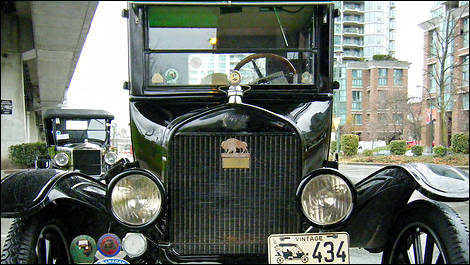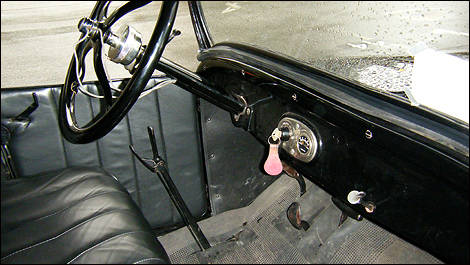The Ford Model T first went on sale in October of 1908, and with a sticker of $825 it wasn't the affordable American dream that it became 17-years later when it sold for just $260. The introduction of the mass-assembly production line in 1915 enabled Henry Ford to build the cookie-cutter vehicles at a rate never before imagined. By May 26, 1927, 15 million Model Ts had been sold to primarily members of the burgeoning middle class in North America and around the world.
Vancouver B.C. In an effort to highlight just how far the world of transportation has come since the Model T was considered cutting-edge, Ford embarked upon a cross Canada exposition to contrast the Model T against the 2009 Ford Flex. The presentation provided journalists with a "first hand" experience behind the wheel of both automotive bookends.
The Flex is an ultra modern people mover that spoils its occupants with outstanding comfort and up-to-date electronics. It's a beauty to drive, and can handle up to six passengers with ease. It also protects its occupants with class-leading technology such as stability control, roll control and a full suite of airbags.
Driving the Flex is all about ease; its V6 dishes-up plenty of power while its antilock disc brakes enable short, controlled emergency stops. None of this can be said about the Model T, although I suspect in its heyday it was considered easy to drive and quite responsive given its 20 horsepower 2.9-litre 4-cylinder engine. The low-revving powerplant pushed the 544-kg (1200-lbs) sled to a top speed of 65-70 k/hr (40-45 mph).
Getting the Model T mobile
If one was lucky enough, their Model T was equipped with an electric starter, otherwise a broken thumb was a high probability if an incorrect technique was applied in gripping the crank handle to manually fire-up the big four-banger.
Once the rugged mill was chugging away, time came to put the buggy into gear and make tracks- narrow ones. My driving instructor took a few moments to explain the unique aspects of driving a Model T. For example, there are three pedals sticking out of the floorboards, none of them connected to the engine.
The left pedal is a clutch of sorts that controls the two-speed transmission. When depressed midway, the transmission is in neutral. Pushing this pedal slowly to the floor engages a band around a low-ratio planetary gear intended for low speed driving. Releasing the pedal disengages low gear and engages a high-ratio planetary gear as the pedal moves through the upper half of its travel.
A lever mounted to the steering column controls the throttle while braking is accomplished using the right foot pedal - you know - the one you'd expect to be the throttle. Confused yet? The last piece of the driveline jigsaw is the centre pedal. Holding the left pedal in its neutral midpoint position and depressing the centre pedal engages reverse.
Vancouver B.C. In an effort to highlight just how far the world of transportation has come since the Model T was considered cutting-edge, Ford embarked upon a cross Canada exposition to contrast the Model T against the 2009 Ford Flex. The presentation provided journalists with a "first hand" experience behind the wheel of both automotive bookends.
 |
The Flex is an ultra modern people mover that spoils its occupants with outstanding comfort and up-to-date electronics. It's a beauty to drive, and can handle up to six passengers with ease. It also protects its occupants with class-leading technology such as stability control, roll control and a full suite of airbags.
Driving the Flex is all about ease; its V6 dishes-up plenty of power while its antilock disc brakes enable short, controlled emergency stops. None of this can be said about the Model T, although I suspect in its heyday it was considered easy to drive and quite responsive given its 20 horsepower 2.9-litre 4-cylinder engine. The low-revving powerplant pushed the 544-kg (1200-lbs) sled to a top speed of 65-70 k/hr (40-45 mph).
Getting the Model T mobile
If one was lucky enough, their Model T was equipped with an electric starter, otherwise a broken thumb was a high probability if an incorrect technique was applied in gripping the crank handle to manually fire-up the big four-banger.
Once the rugged mill was chugging away, time came to put the buggy into gear and make tracks- narrow ones. My driving instructor took a few moments to explain the unique aspects of driving a Model T. For example, there are three pedals sticking out of the floorboards, none of them connected to the engine.
The left pedal is a clutch of sorts that controls the two-speed transmission. When depressed midway, the transmission is in neutral. Pushing this pedal slowly to the floor engages a band around a low-ratio planetary gear intended for low speed driving. Releasing the pedal disengages low gear and engages a high-ratio planetary gear as the pedal moves through the upper half of its travel.
A lever mounted to the steering column controls the throttle while braking is accomplished using the right foot pedal - you know - the one you'd expect to be the throttle. Confused yet? The last piece of the driveline jigsaw is the centre pedal. Holding the left pedal in its neutral midpoint position and depressing the centre pedal engages reverse.
 |
| 1926 Model T Runabout |


